Using Sclerotherapy to Get Rid of Varicose Veins
What are Varicose Veins?
 Varicose veins, which are caused by weakened circulatory valves, usually
appear on the legs. Most commonly these unsightly veins show up on the thighs,
insides of the legs, or on the calves. Looking like twisted, bulging cords, the
veins can be colored blue or red but they may appear flesh-colored too. Varicose veins, which are caused by weakened circulatory valves, usually
appear on the legs. Most commonly these unsightly veins show up on the thighs,
insides of the legs, or on the calves. Looking like twisted, bulging cords, the
veins can be colored blue or red but they may appear flesh-colored too.
Why Varicose Veins Develop
Around half the population of women and 40 percent of men in the United
States suffer from varicose veins, with approximately 50% of the population over
50 years old exhibiting varicose symptoms. Therefore, as time progresses, your
risk of getting varicose veins also increases as well. Other influences such
as heredity, hormonal changes, lack of exercise, obesity, and pregnancy, can
cause the veins to develop too.
The valves in the legs are designed with one-way flaps. They are designed to
keep the blood flowing upwards in its journey to the heart. However, if these
flaps become weak, then the blood will begin to pool and collect. When this
occurs, a condition known as venous insufficiency results, thereby leading to
varicosity.
Because of the force of gravity and extra body weight, the pressure of
carrying blood upwards can be greater than what the valves of the veins can
manage. That's why varicose veins frequently develop in the legs.
Symptoms Associated with Venous Insufficiency or Varicose Veins
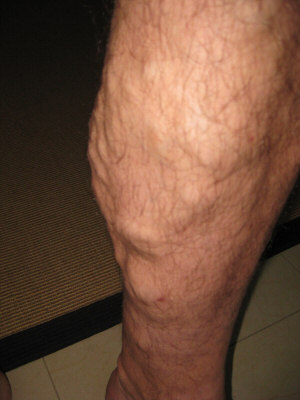 Varicose veins that appear in the legs may also cause the following symptoms: Varicose veins that appear in the legs may also cause the following symptoms:
- A feeling of heaviness in the legs
- Throbbing or aching of the legs
- Irritation, marked by a rash
- Restlessness
In severe instances, the skin may start to darken too.
Serious Health Issues That Can Develop from Varicosities
While varicose veins may not cause any of the aforementioned symptomatology,
the problem should, nonetheless, be addressed as more serious health issues can
result, including the following:
- Bleeding, especially if the skin covering the veins is thin, all which
can cause a substantial loss of blood.
- Skin ulcers or sores on the ankles or legs.
- Superficial thrombophlebitis, which is exhibited by such symptoms as warmth
and tenderness at the vein site and, in some instances, swelling, pain, or skin
redness. The condition develops when a blood clot forms in a vein just beneath
the skin's surface.
- Deep vein thrombosis. This condition results when a blood clot forms in
a deeper vein. Some patients complain that they feel a pulling in their
calf, accompanied by warmth, pain, swelling, or redness. Other patients may
not experience any kind of symptoms at all. Deep vein thrombosis should be
treated immediately as it can lead to death if the clot breaks away and
travels to the lungs.
Deep vein thrombosis:

By James Heilman, MD
via Wikimedia Commons
When You Should You Talk to a Doctor
So, if you have varicose veins, it's imperative to see a doctor about the
problem if a vein has become warm or tender to the touch and is swollen or red.
You should also see a health care provider if you have a rash or sores on your
leg or around your ankles. If the varicose vein starts to bleed, or your daily
routine is affected by the condition, then it's essential that you talk to a
doctor without delay.
Superficial Venous Reflux Disease
When varicose veins cause leg heaviness, cramping, throbbing, or aching, then
the condition is referred to as superficial venous reflux disease or venous
insufficiency. Even if you don't exhibit varicose veins visually. you may be
suffering from a condition that is effected only the deeper veins. Veins that
don't appear at the skin's surface may be affected without the patient knowing
it. Therefore, you can suffer from superficial venous reflux disease with or
without the appearance of varicosities.
Telangiectasias (Spider Veins)
|
Spider Veins:
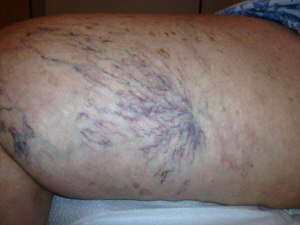
|
Smaller veins, called spider veins, can also develop from venous
insufficiency. However, these veins, which are much smaller than the varicose
kind, appear closer to the skin's surface. Often colored red, purplish, or blue,
the veins, and as their name suggests they branch out like a spider's web. The
smaller veins are usually seen on the face or legs. Spider veins, known as
telangiectasias, may also appear as the result of an overexposure to the sun or
because of trauma or an injury. The veins frequently appear on the face on
either the nose or cheeks.
Sclerotherapy: A Common Vein Removal Procedure
A common treatment used to treat varicose veins or spider veins is
sclerotherapy. In this procedure, the doctor injects a chemical solution, called
a sclerosant, into the affected vein, which, in turn, causes the vein walls to
swell and then seal shut. This process stops the blood flow and causes the
injected vein to turn into scar tissue over time. After a few weeks, the vein
will fade from view. Patients like this treatment as it can be facilitated
without anesthesia in the doctor's office. In fact, many patients can return to
work after the treatment process.
Treatment Sessions for Sclerotherapy
Sclerotherapy treatments typically take place more than one time, with the
number of sessions contingent on the size of the veins, their depth, and number.
Sessions usually last about fifteen to thirty minutes, with each appointment
scheduled about four weeks apart.
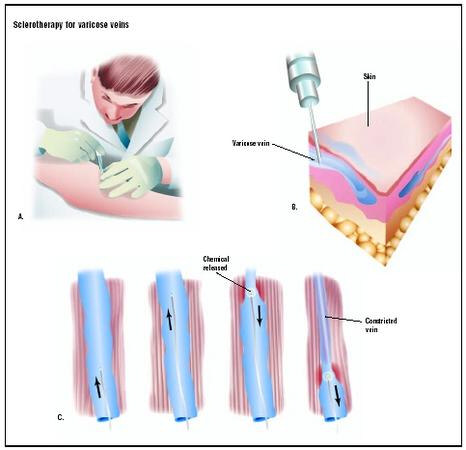
When Sclerotherapy Results are Seen
Results for treating spider veins appear in about three to six weeks. If the
procedure is used for treating small or medium varicose veins, then results are
seen after about four months' time.
A Minimally Invasive Treatment Option
After varicose vein treatment, you may be advised to wear a compression
stocking in order to promote healing and reduce swelling.
Compression Stockings
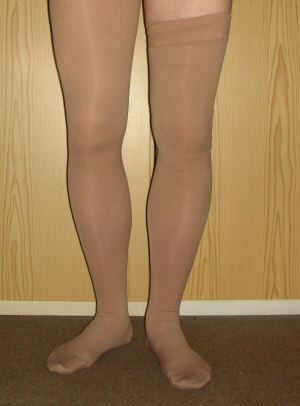
By Hutschi
via Wikimedia Commons
While patients can
experience some itching or bruising at the injection site, any discomfort
quickly subsides. An over-the-counter pain medicine is typically recommended to
manage pain. Because sclerotherapy is considered minimally invasive, very few
side effects result from the therapy.
Removing Large Varicose Veins
Usually, sclerotherapy is recommended for people with spider
veins (telangiectasias) or varicose veins that are small or medium in size. Large
varicose veins may be treated by such modalities as vein stripping, which
requires making small cuts into a vein site before removing the vein, or by the
use of thermal energy, which shrinks the vein walls. This type of ablative
therapy is often combined with foam sclerotherpay. Foam sclerotherapy makes use
of a sclerosant as well as a mild detergent in the vein removal process. In some
cases, surgery, such as ambulatory phlebectomy, is recommended to get rid of a
large surface vein.
|
Ambulatory phlebectomy surgery:
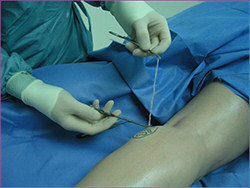
|
After Sclerotherapy Treatment
After sclerotherapy is performed, it's essential that patients develop a
regular walking routine in order to encourage healthy circulation. Sclerotherapy
is considered safe to use on the legs as well as on the arms, hands, and facial
areas.
When Sclerotherapy is Not Advised
However, that all being said, certain people should avoid the procedure,
especially pregnant or nursing women, patients who've had a history of deep vein
thrombosis, or anyone who is currently taking anticoagulant medications or
corticosteroids.
Diseases & Conditions
Top Lists:
Top 10 Most Common Genetic Disorders
Top 15 Most Disturbing Skin Conditions
10 Unusual Phobias
Informational:
Diverticular Disease and Diverticulitis
What is Turner Syndrome and Why Does it Affect Only Females?
Alice in Wonderland Syndrome and How to Treat the Symptoms
Herniated Disc: Symptoms and Treatments
Pinch Nerve: The Cause of Remote Pain
Dealing With a Child Who Has a Fever
How Unhealthy Diet Could Trigger Inflammatory Arthritis
Phobias: Understanding How They Develop and Treatments
Depression Facts, Symptoms & Treatment
Earaches - Causes and Treatments
Symptoms of Borderline Personality Disorder and How to Deal with It
Seasonal Affective Disorder: Does Light Therapy Help?
What Really Causes Dandruff and How Can You Treat the Symptoms
Treating Plantar Fasciitis or Heel and Arch Pain
Symptoms and Treatments of Aplastic Anemia
Using Sclerotherapy to Get Rid of Varicose Veins
Are the Side Effects of HGH Supplements Worth It?
ADD/ADHD Symptoms and Treatment
What are the Options for Hair Loss Treatments
Options for Frontal Hair Loss Treatment |